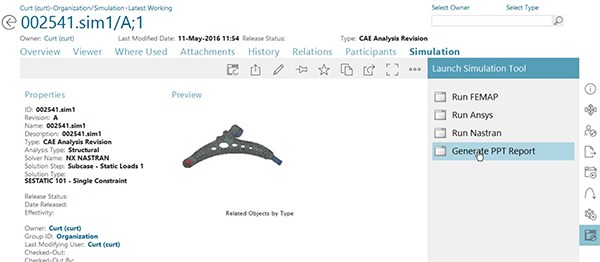Simulation Silos
As access to compute resources expands, and new tools shift simulation to engineers and designers, the volume of simulation data has increased.

Image courtesy of Getty Images/antpkr.
Latest News
July 1, 2019
Simulations are now conducted earlier in the design process and more frequently, and new tools have helped integrate different types of analysis into the daily workflows of designers. The amount of data has increased, which means the task of managing that data effectively so that it can be shared, stored, searched and reused in the future is even more challenging.
Simulation data management has become more critical as companies look for ways to better leverage existing simulations to improve designs or create new products, or because they must be able to access the data for compliance or regulatory purposes. However, many companies have done a poor job of properly categorizing and storing the data, which impacts their ability to meet rapidly accelerating design cycles.
“If you can cut down simulation times and the amount of time needed to respond to a requirements change, that has an impact on how fast you can meet deadlines,” says Sanjay Angadi, director of product management at ANSYS. “Being able to catalog best practices, manage them and deploy them through a data management solution can directly impact the product lifecycle, and how well you are able to manage, share and redo that work on the next program.”

Why not use traditional product data management (PDM) or product lifecycle management (PLM) tools? Simulation data is a much different animal than traditional product data. Designs often have multiple configurations, changes or iterations. A single version may have been subject to hundreds of simulations, and not all versions or tests may be worth keeping.
Simulation data is not only voluminous, but may also have a short lifecycle depending on the product or industry. Simulation cuts across multiple physics domains, each with different solvers and different ways to represent the product geometry. Even the data itself can be quite complex. Engineers often have to simultaneously conduct multiple types of simulations, in addition to accessing past simulation runs either for compliance purposes or to reduce redundancy.
“Almost every customer you can speak to faces problems of not being able to find data easily, not being sure the data is current when starting simulations, or if each person doing simulations may be using a different version of the design,” says Ravi Shankar, global simulation product marketing director at Siemens PLM Software. “Secure transfer of data across different sites is also a problem.”
Simulation data management also requires not just tracking results, but tracing the design information used to create the simulation, the input data used and the version of the application software that created the simulation.
Simulation models are often generated by various different tools from multiple vendors, often over lengthy periods of time during product development and updates. In some cases, accessing that data may require using the older hardware or software used in that particular simulation. Locating data is also a challenge—ensuring that companies not only have access to the right models, but also the right data input and information that analysts used to make their decisions can be nearly impossible without some accurate and automated way to tag and store that data.
Evolving Simulation Data Management Tools
Software providers have responded with many tools that target the organization, storage, management and retrieval of this simulation data. ESTECO’s Simulation Data Management solution provides a way to access, organize and share simulation data, for example, while Altair offers SimData Manager to provide access to CAE data via a partnership with PDTec AG. The solution traces CAD geometries throughout the design process so that engineers can know which geometry formed the basis of the simulation models, and analysts can be notified of CAD model updates during simultaneous engineering processes.
ESI Group offers the Vdot simulation data management software to help organize and provide access to data. The company’s VisualDSS solution also makes it easier to share models and resolve conflicts so that engineers can identify the optimal designs based on different physics and parameters. Users can build and maintain a bidirectional link between CAD data stored in PLM systems and simulation domains. Design and engineering changes can be propagated across the virtual tests, while maintaining data traceability.
“You can combine dynamically the impact of a modification from one domain to another, and the conflict is managed by default,” says Jean Louis Duval, innovation and discovery business unit director at ESI Group.
“You can see what the impact is of one parameter on all domains,” Duval. “This type of approach changes the way you perceive the management system, because now you don’t need to manage thousands of inputs and versions. You can track those modifications back to the model. It changes our vision of SPDM, because you don’t need to manage those conflicts any more, and you don’t need to have a specific tool. You can reuse existing simulations to build your plan on the fly.”
The types of challenges that companies need to address with SPDM will vary by company. Shankar says that some customers are interested in streamlining simulation processes so that it’s easy to retrieve analysis results and create reports, and to ensure that this process is executed the same way no matter who is involved. Model re-use is another issue—data management can help ensure that different groups analyzing different physics can start from the same CAD version or re-use existing meshes.
“If you look at the auto industry, you may have teams of engineers working on a single product, and there may be 10 or 20 variants of the same analysis,” says Mark Lamping, SimCenter 3D business development manager at Siemens PLM Software. The Siemens Teamcenter Simulation Management tool provides control over CAE processes in the context of a PLM environment.
“Each crash simulation is a unique model, but a lot of that data can be shared,” Lamping explains. “You don’t have to recreate the same data over and over again. Teamcenter gives you the ability to share that data efficiently, and with confidence [so] that you have the data you need for your model.”
The ANSYS Engineering Knowledge Manager is a web-enabled system that can integrate heterogeneous simulation tools and improve the management and sharing of simulation data.
“Our No. 1 challenge was making sure we could leverage multiphysics in an efficient way,” says Angadi. “Customers are using dozens of tools. We take a very holistic view, because this not just a data management issue. You need a domain-specific view. We’re providing optimization and robust design tools that allow them to be more productive. We’re not just handing them a data management tool, but looking at how effectively they are using those tools, and what are the best mechanisms for automation.”
The tools also have to fit into the engineers’ daily processes without impacting their productivity. “That is critical,” Angadi says. “You need a combination of data and process management tools that will fit into their existing processes and integrate into their day-to-day activities.”
That’s why manual tagging or metadata creation is usually a non-starter. “You need automated routines of getting smart metadata,” Angadi adds. “Things relevant to simulation get indexed, and then users can come in and find them quickly.”
Relevancy also comes into play when it comes to managing the large volume of simulation data now being generated. It may not be possible to move all simulation data into a central repository; in some cases, large analysis files may be discarded fairly quickly after they are generated. The SPDM tool should help ensure that key results are added to the database, as well as helping to automate the process of sorting that data.
“There are mechanisms for doing this if you don’t want to store all the files forever,” Angadi says. “You can use a lightweight visualization that doesn’t keep the large files, but does keep the input deck and some of the important information. Some customers have a 90-day policy. In some fields, like aerospace, there might be a need to carry the data forward.”
“Depending on the type of simulations, the files can be huge,” Shankar says. “Companies need to make a decision where to store the data. For example, in Teamcenter, the storage can be online, nearline, and the data can be stored in external databases if need be.
“There are certain types of data that you might want to always access within the system, while other types could be archived,” Shankar says. “What would be stored within the system is a link or a subset of data extracted from the simulation. You can do quick comparisons when making design changes. The flexibility needs to be in the system so each company can address their specific needs.”
Cultural Hurdles
There are still some gaps in SPDM that vendors are working to address. Shankar sees an emerging need for a simulation data management system that can encompass electronic and software content in addition to mechanical simulation. “That’s an area that is evolving, and perhaps along with that is an opportunity to bring in IoT data and feed that into the development process,” he says. “I think a lot of work has yet to be done there.”
According to Duval, the biggest challenge remains getting analysts and engineers to shift away from siloed operations to processes that make it easier to access and share simulation data.
“The biggest challenge is not on the technology side for SPDM, but on the human side,” Duval says. “Organizational workflow processes are still one of the biggest bottlenecks.”
With a robust data management tool in place, engineering firms can improve simulation processes and compliance, while lowering the cost of finding information and creating reports. This can ultimately improve designs and reduce redundancies with updated designs or similar designs that are being created.
“Our customers know that they can’t continue to do what they were doing before,” Angadi says. “Simulation is so critical to the design process, that they have to look at the re-use and collaboration piece more holistically.”
More Altair Coverage
More Ansys Coverage
More ESI Coverage
More ESTECO Coverage
More Siemens Digital Industries Software Coverage
Subscribe to our FREE magazine, FREE email newsletters or both!
Latest News
About the Author
Brian Albright is the editorial director of Digital Engineering. Contact him at [email protected].
Follow DE





